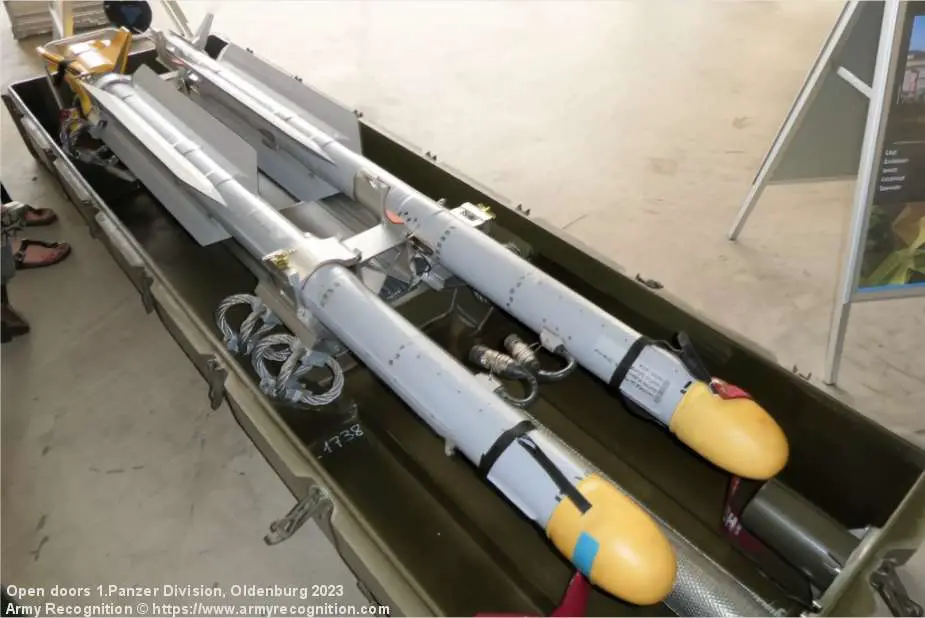Breaking news
Germany to export 150 Iris-T air-to-air missiles to Saudi Arabia.
As reported by the Deutsche Presse-Agentur (DPA) on January 10, 2024, the German government has approved the export of 150 Iris-T air-to-air missiles to Saudi Arabia, a decision that marks a shift in the country's arms export policy. The missiles, manufactured by Diehl Defence in Baden-Württemberg, are intended for use with the Saudi Air Force's Eurofighter jets.
Follow Air Recognition on Google News at this link
 Iris-T air-to-air missiles on display at the Open Doors event of the 1st Panzer Division in Oldenburg, Germany, 2023. (Picture source: Army Recognition)
Iris-T air-to-air missiles on display at the Open Doors event of the 1st Panzer Division in Oldenburg, Germany, 2023. (Picture source: Army Recognition)
Details of this decision were revealed in a letter from German Economy Minister Robert Habeck to the Economic Affairs Committee of the parliament. This was also confirmed by government spokesman Steffen Hebestreit and reported by the Deutsche Presse-Agentur (DPA).
This approval follows recent statements by the German government, suggesting a more open stance towards arms exports to Saudi Arabia, particularly in relation to Eurofighter jets. Foreign Minister Annalena Baerbock, supported by Chancellor Olaf Scholz, indicated that the government would not oppose the delivery of Eurofighters to Saudi Arabia, recognizing Saudi Arabia's actions in intercepting missiles aimed at Israel from Yemen.
This development signifies a change in the approach of Chancellor Scholz's coalition government towards arms exports to Saudi Arabia. The policy had previously been more restrictive, especially following the cessation of arms exports initiated in 2018 by the government under Chancellor Angela Merkel, in response to Saudi Arabia's involvement in the Yemen war.
The Scholz coalition government, comprising the SPD, Greens, and Free Democrats (FDP), has authorized considerable arms exports to Saudi Arabia, including €44.2 million worth in 2022 and €13.3 million by the end of November 2023.
During a visit to Riyadh, Economy Minister Habeck did not directly comment on the decision, citing confidentiality. He noted that decisions on arms exports consider various factors, including the needs of other partners and the potential role of the weapons in contributing to protection and stability.
Introduced in 2005, the IRIS-T (InfraRed Imaging System Tail/Thrust Vector-Controlled) is a medium-range air-to-air missile developed through a cooperative program involving several European countries, including Germany, Greece, Italy, Norway, Sweden, and Spain. This program aimed to create a new missile system to replace older models like the AIM-9 Sidewinder. The IRIS-T has been designed for use in air-to-air engagements as well as for ground defense roles.
A key feature of the IRIS-T is its agility, attributed to a combination of thrust vectoring and aerodynamic control. This feature allows the missile to engage targets at various positions relative to the launching aircraft. The IRIS-T is equipped with an imaging infrared seeker head, which is integrated with image processing technology, intended to improve target acquisition and tracking. Target designation can be achieved through airborne radar or via the pilot's helmet sight, offering flexibility in different combat situations. The missile is compatible with several types of fighter aircraft, such as the Eurofighter, F-16, EF-18, Tornado, and Gripen.
In addition to its air-to-air role, the IRIS-T has been adapted for surface-launched operations, like the IRIS-T SLS (Surface Launched System), which is designed for short-range defense. In 2016, the Norwegian Air Force tested the IRIS-T in a maritime role, indicating its utility in various domains.
Primarily manufactured by the German company Diehl Defence, the IRIS-T weighs 87.4 kg and is 2.94 m long with a diameter of 127 mm and a wingspan of 447 mm. The missile is equipped with a high-explosive/fragmentation warhead, detonated by impact, and an active radar proximity fuse. It is powered by a solid-fuel rocket and has an operational range of up to 25 km, capable of flying at altitudes from sea level to 20,000 m (66,000 ft) and reaching a maximum speed of Mach 3. The IRIS-T's guidance system primarily uses infrared homing, with the IRIS-T SLX variant incorporating radar homing.


























